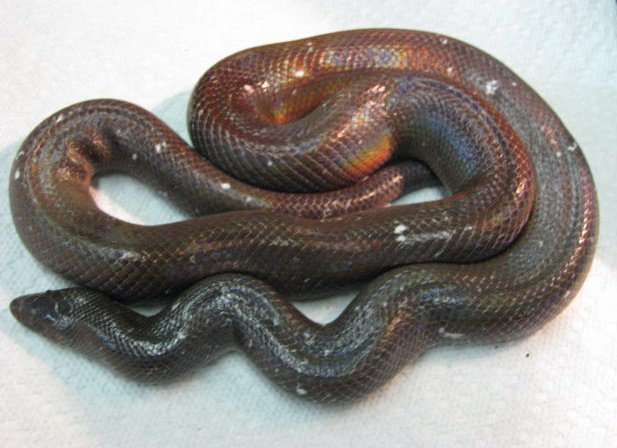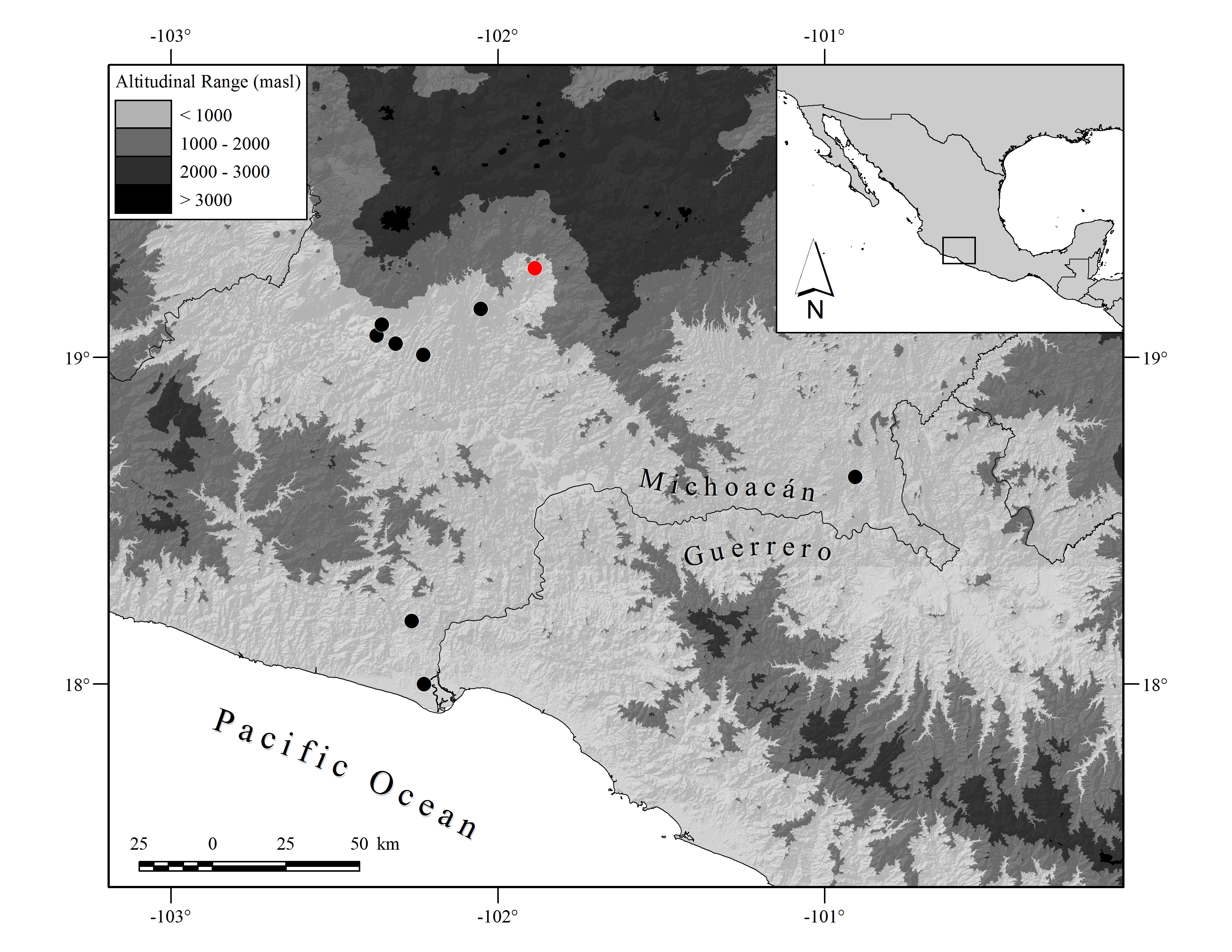


Loxocemus bicolor (SERPENTES: LOXOCEMIDAE): ELEVATIONAL AND GEOGRAPHIC RANGE EXTENSION IN MICHOACÁN, MÉXICO.
Loxocemus bicolor (SERPENTES: LOXOCEMIDAE): EXTENSIÓN DE LA DISTRIBUCIÓN GEOGRÁFICA Y RANGO DE ALTITUD EN MICHOACÁN, MÉXICO.
Rubén Alonso Carbajal-Márquez1*, Jose Carlos Arenas-Monroy2, Marco Antonio Domínguez-De la Riva3 and Eric Abdel Rivas-Mercado3
1Centro de Investigaciones Biológicas del Noroeste, Instituto Politécnico Nacional No.195 Col. Playa Palo de Santa Rita Sur, C. P. 23096, La Paz, Baja California Sur, México. *redman031@hotmail.com
2Laboratorio de Herpetología, Museo de Zoología, Departamento de Biología Evolutiva, Facultad de Ciencias, Universidad Nacional Autónoma de México, 04510. Distrito Federal, México. jca_exe@yahoo.com.mx
3Universidad Autónoma de Aguascalientes, Centro de Ciencias Básicas, Departamento de Biología, Avenida Universidad No. 940, Aguascalientes, Aguascalientes 20131, México. biol.marcoantonio@gmail.com, rme.abdel@hotmail.com
Abstract. We document the occurrence of Loxocemus bicolor in the arid tropical scrub forest at Hoyo del Aire, Municipality of Taretan, Michoacán; an adult specimen that represents a new municipality record, which increases the geographic range and elevational gradient of the species in the state.
Keywords: Mexican Burrowing Python, Taretan, Squamata.
Resumen. Se registra la presencia de Loxocemus bicolor en el bosque tropical caducifolio de Hoyo del Aire, municipio de Taretan, Michoacán; un ejemplar adulto que representa un nuevo registro municipal y que incrementa la distribución geográfica y el gradiente de altitud para la especie en el estado.
Palabas Clave: Pitón de Madriguera Mexicano, Taretan, Squamata.

Figure 1. Adult specimen of Loxocemus bicolor (LSUDPC 7003), from Hoyo del Aire, Taretan, Michoacán.
The Mexican burrowing python is the only species in the monotypic genus Loxocemus and family Loxocemidae (Uetz 2013). It lives in dry forests and savannas, from sea level up to ~600 meters above sea level (masl), from Nayarit, México to Costa Rica on the Pacific Versant, and on the Atlantic Versant from Guatemala to Honduras (Nelson and Meyer 1967, Savage 2002). Loxocemus bicolor spends most of the time underground inside self-constructed burrows; however, it has been collected in rock piles, under leaf litter, logs, basking on the surface or on roads (Nelson and Meyer 1967).
This medium-sized snake can reach 1530 mm in total length (Savage 2002). Whiptail lizards (Aspidoscelis), juvenile iguanas (Iguana iguana), and small rodents have been reported as prey items for L. bicolor, as well as sea turtle (Lepidochelys olivacea), Ctenosaura similis and Iguana iguana eggs (Greene 1983, Mora and Robinson 1984, Mora 1987). This is an oviparous species, with the largest documented clutch of four eggs (Köhler 2003). However, because of its semifossorial habits, the natural history of this species is poorly known.
In Mexico L. bicolor occurs at low and moderate elevations, from Nayarit to Chiapas including the Río Grijalva basin, with most records clustered around major highways (Nelson and Meyer 1967; Ramírez-Bautista and Arizmendi 2004). It´s catalogued in the Norma Oficial Mexicana in special protection (Pr), not evaluated in the IUCN, and in the category of medium vulnerability species in Michoacán due to its restricted distribution within the state (Alvarado-Díaz et al. 2013). The arid tropical scrub forest is the most extensive tropical habitat in the Michoacán lowlands and slopes, and occurs across two biogeographic provinces, the Pacific Coastal Plains and the Balsas-Tepalcatepec Valley. Duellman (1965) noted L. bicolor is rare in arid tropical scrub forest of Michoacán, within 0 to 640 masl, and represented by roughly 11 museum specimens, with only 9 of these associated with locality data. Seven of these specimens are from the Balsas-Tepalcatepec Valley including one for the Municipality of Huetamo (Reyna-Álvarez et al. 2010), one for the Municipality of Gabriel Zamora, and five for the Municipality of Apatzingán (Nelson and Meyer 1967, HerpNET 2014). There are two specimens from the Pacific Coastal Plains, one for the Municipality of Lázaro Cárdenas, and one for the Municipality of Arteaga (Peters 1954, HerpNET 2014). Here we document an additional specimen of L. bicolor for the Balsas-Tepalcatepec Valley, northeast of previous records.

Figure 2. Map depicting known records of Loxocemus bicolor in Michoacán. Black dots represent previous records, and the red circle the new record.
On 31 August 2010 ca. 1200 h, during an herpetological survey, we found an adult male L. bicolor under a pile of rocks at the base of a Ficus sp. tree at Hoyo del Aire, Municipality of Taretan, Michoacán (photographic vouchers LSUDPC 7003-7004; 19.272461°,-101.886725°; WGS 84), elevation 979 masl, in arid tropical scrub forest. The snake was released after taking photos. The photographic vouchers of the snake were verified by L. Lee Grismer. This new Municipality record extends the geographic range of the species ca. 22.26 km NE of 1.77 km S Lombardía, Michoacán (628 masl; Nelson and Meyer 1967), and represents the most inland record for the state. Furthermore, this record is significant because it increases the elevational range of L. bicolor by 339 m within Michoacán.
Acknowledgments. We thank R. Hansen for comments on a previous draft of this note. We also thank SEMARNAT for approving this research (permit number SGPA/DGVS/04324).
Literature Cited.
Alvarado-Díaz, J., I. Suazo-Ortuño, L. D. Wilson and O. Medina-Aguilar. 2013. Patterns of physiographic status of the herpetofauna of Michoacán, Mexico. Amphibian and Reptile Conservation 1: 128-170.
Duellman, W.E. 1965. A biogeographic account of the herpetofauna of Michoacán, México. University of Kansas Publications, Museum of Natural History 15(14): 627-709.
Greene, H.W. 1983. Dietary correlates of the origin and radiation of snakes. American Zoologist 23(2): 431-441.
Köhler, G. 2003. Reptiles of Central America. Germany: Herpeton-Verlag. 367 p.
Mora, J.M. 1987. Predation by Loxocemus bicolor on the eggs of Ctenosaura similis and Iguana iguana. Journal of Herpetology 21(4): 334-35.
Mora, J.M. and D.C. Robinson. 1984. Predation of sea turtle eggs (Lepidochelys) by the snake Loxocemus bicolor Cope. Revista de Biología Tropical 32(1): 161-162.
Nelson, C.E. and J.R. Meyer. 1967. Variation and distribution of the Middle American snake genus, Loxocemus Cope (Boidae?). The Southwestern Naturalist 12(4): 439-453.
Peters, J.A. 1954. The amphibians and reptiles of the coast and coastal sierra of Michoacán, México. Occasional Papers of the Museum of Zoology, University of Michigan 554:1-37.
Ramírez-Bautista, A. and M.C. Arizmendi. 2004. Loxocemus bicolor. Sistemática e historia natural de algunos anfibios y reptiles de México. SNIB-CONABIO, Proyecto W013. Electronic Database accessible at: http://www.conabio.gob.mx/institucion/proyectos/resultados/W013_Fichas%20de%20Especies.pdf
Reyna-Álvarez, J., I. Suazo-Ortuño and J. Alvarado-Díaz. 2010. Herpetofauna del municipio de Huetamo, Michoacán, México. Biológicas 12(1): 40-45.
Savage, J.M. 2002.The amphibians and reptiles of Costa Rica: A herpetofauna between two continents, between two Seas. USA: University Of Chicago Press. 954 p.
Uetz, P. 2013. The Reptile Database. Electronic Database accessible at: http://www.reptile-database.org
